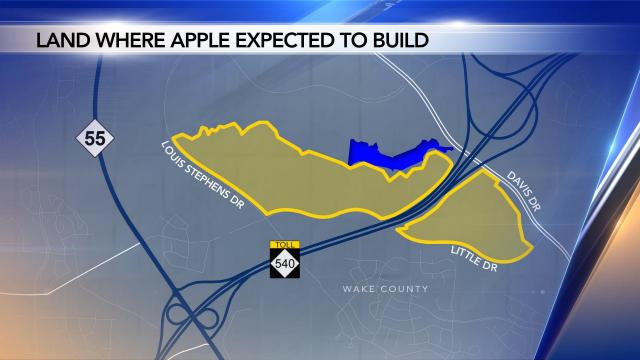RESEARCH TRIANGLE PARK — More than 18 months after the news broke that Apple planned to come to North Carolina, no progress – as far we can tell – has been made at the site where the corporation plans to build its $1 billion campus.
The company’s expansion and latest commitment to North Carolina includes adding 3,000 jobs and investing a billion dollars into the economy here through the campus at RTP. The state propositioned the corporation with a hefty incentive package.
A new WRAL analysis shows not only is it the largest in the company’s history, but it is more than they receive from every other state company combined.
Since 2009, North Carolina has offered Apple $1.2 billion through nine different incentive programs, according to the subsidy tracker maintained by Good Jobs First.
Good Jobs First is a group that promotes accountability in economic development.
Not only is the $1.2 billion the highest incentive amount from any state where records are available, but it is 2.5 times the total amount Apple has received from every other state combined.
“Apple’s a game changer,” said Dr. Mike Walden, an economist who developed the Walden Model. “It’s an iconic firm, it’s going to encourage growth and the triangle.”
The state uses an algorithm Walden created to weigh the pros and cons of offering incentives to large corporations like Apple.
“This is a poker game, in some sense,” Walden said. “North Carolina is now participating with a lot of chips.”
The model is like a scale and calculates the economic impact, both direct and indirect, Walden explained. Those include employee salaries and tax revenue generated, along with impacts for local suppliers and increased retail sales. In all, the model estimates that would be around $3.4 billion a year.
Then, the model compares those benefits to the costs like how much the state will lose in tax revenue from the incentives, along with other costs like the ones related to public services. In this case, it is estimated at $1.4 billion. So the state stands to make $2 billion each year while paying just up to $28 million annually in incentives for the 39-year term.
However, opponents say these grants and incentives give corporations an unfair advantage.
“The taxes that those corporations are not paying need to be made up by somebody and that somebody is going to be all the other business owners and entrepreneurs across the state,” said Brian Balfour, with the John Locke Foundation.





